Trapani
Trapani (US: /ˈtrɑːpəni/ TRAH-pə-nee, Italian: [ˈtraːpani] (![]()
Trapani | |
|---|---|
| Comune di Trapani | |
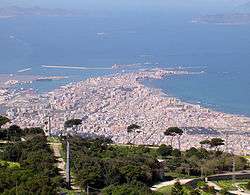 | |
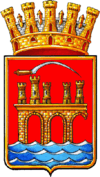 Coat of arms | |
.svg.png) The comune of Trapani within the province of Trapani | |
Location of Trapani 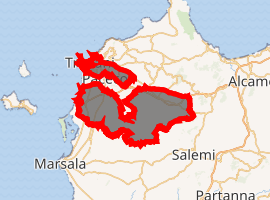
| |
 Trapani Location of Trapani in Italy 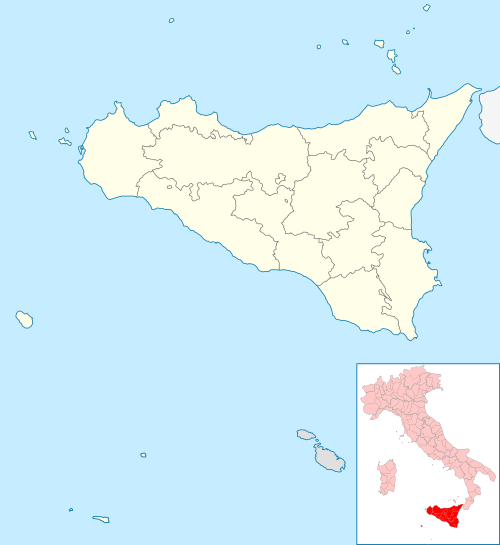 Trapani Trapani (Sicily) | |
| Coordinates: 38°01′N 12°31′E | |
| Country | Italy |
| Region | Sicily |
| Province | Trapani (TP) |
| Frazioni | Marausa, Xitta, Palma, Fontanasalsa, Guarrato, Fulgatore, Salinagrande, Locogrande, Rilievo, Borgo Fazio, Ummari |
| Government | |
| • Mayor | Giacomo Tranchida (PD) |
| Area | |
| • Total | 271 km2 (105 sq mi) |
| Elevation | 3 m (10 ft) |
| Population (31 March 2020)[2] | |
| • Total | 67,531 |
| • Density | 250/km2 (650/sq mi) |
| Demonym(s) | Trapanese |
| Time zone | UTC+1 (CET) |
| • Summer (DST) | UTC+2 (CEST) |
| Postal code | 91100 |
| Dialing code | 0923 |
| Patron saint | St. Albert |
| Saint day | August 7 |
| Website | Official website |
History
Drepana was founded by the Elymians to serve as the port of the nearby city of Eryx (present-day Erice), which overlooks it from Monte Erice. The city sits on a low-lying promontory jutting out into the Mediterranean Sea.
It was originally named Drépanon from the Greek word for "sickle", because of the curving shape of its harbour. Carthage seized control of the city in 260 BC, subsequently making it an important naval base, but ceded it to Rome in 241 BC following the Battle of the Aegates in the First Punic War.
Two ancient legends relate supposed mythical origins for the city. In the first legend, Trapani stemmed from the sickle which fell from the hands of the goddess Demeter while she was seeking for her daughter Persephone, who had been kidnapped by Hades. The second myth features Kronos, who eviscerated his father Ouranos, god of the sky, with a sickle which, falling into the sea, created the city. In ancient times, Saturn (i.e., the Punic god Baal Hammon) was the patron god of Trapani. Today, Saturn's statue stands in a piazza in the centre of the city.

After its Roman, Vandal, Ostrogoth, Byzantine and (from 827) Arab conquests, Trapani was taken by the Normans of Roger I in 1077, flourishing under their dominations and having also a role in the Crusades as one of the most important ports in the Mediterranean Sea. In the 17th century, the city decayed due to revolts, plagues, and famines, but in the following century, it grew from 16,000 to 30,000 inhabitants; commerce remained of local importance, while its military position in the Kingdom of Naples remained notable.
The city was badly damaged during World War II, when it was subjected to intense Allied bombardments. It has grown greatly since the end of the war, sprawling out virtually to the foot of Monte San Giuliano. Tourism has grown in recent years due to the city's proximity to popular destinations such as Erice, Segesta, and the Egadi Islands.
Government and demographics
The comune of Trapani consists of two discontiguous parts separated by the comune of Paceco. The northern part includes much of the city and some rural area; the much larger southern part includes the area of Marausa, half of Trapani-Birgi Airport and a large rural area. The comune does not include the north-eastern suburbs of the urban area, such as Casa Santa, which are part of the comune of Erice. The comune of Trapani has a population of 70,000, less than the 80,000 of Marsala, the most populous comune in the province. The entire urban area of Trapani, including those parts in the comune of Erice, has over 90,000 residents.
Economy
Much of Trapani's economy still depends on the sea. Fishing and canning are the main local industries, with fishermen using the mattanza technique to catch tuna. Coral is also an important export, along with salt, marble, and marsala wine. The nearby coast is lined with numerous salt-pans. These saltpans were formed by the evaporation of seawater and are situated majestically along the coast road between Trapani and Marsala.
The city is also an important ferry port, with links to the Egadi Islands, Pantelleria, Sardinia, and Tunisia. It also has its own airport, the Trapani-Birgi Airport.
Main sights
Much of the old city of Trapani dates from the later medieval or early modern periods; there are no extant remains of the ancient city. Many of the city's historic buildings are designed in the Baroque style. Notable monuments include:
- The Church of Sant'Agostino (14th century), with the splendid rose-window
- The Church of Santa Maria di Gesù (15th–16th centuries)
- The magnificent Basilica-Sanctuary of Maria Santissima Annunziata (also called "Madonna di Trapani") originally built in 1315–1332 and rebuilt in 1760. It houses a marble statue of the Madonna of Trapani, which might be the work of Nino Pisano, and the Museo regionale Agostino Pepoli.
- Fontana di Tritone ("Triton's Fountain")
- The Baroque Palazzo della Giudecca or Casa Ciambra.
- The Cathedral (built in 1421, but restored to the current appearance in the 18th century by Giovanni Biagio Amico). It includes an Annunciation attributed to Anthony van Dyck.
- Church of Maria SS. dell'Intria, another notable example of Sicilian Baroque.
- Church of Badia Nuova, a small Baroque church.
- Castello di Terra, a ruined 12th-century castle.
- Ligny Tower, a 17th-century watchtower housing an archaeological museum.
Monte Erice is a cable car ride from the city and aside from the cobbled streets and medieval castle, there are views of Tunisia and Africa from up there on clear days.
Several beaches run along the coast of Trapani, the best of which are at Marausa about 9 km (6 mi) south of the city.
Culture
The city is renowned for its Easter related Holy Week activities and traditions, culminating between Good Friday and Holy Saturday in the Processione dei Misteri di Trapani, colloquially simply the Misteri di Trapani (in English the Procession of the Mysteries of Trapani or the Mysteries of Trapani), a day-long passion procession organized and sponsored by the city's guilds, featuring twenty floats of wood, canvas and glue sculptures, mostly from the 17th and 18th centuries, of individual scenes of the events of the Passion.
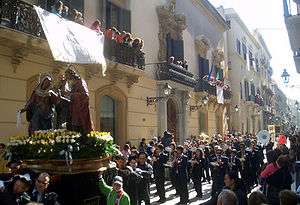
The Misteri are among the oldest continuously running religious events in Europe, having been played every Good Friday since before the Easter of 1612. Running for at least 16 continuous hours, but occasionally well beyond the 24 hours, they are the longest religious festival in Sicily and in Italy. Important also to the cult of the Madonna of Trapani.
The city gives its name to a variety of pesto – pesto alla trapenese – made using almonds instead of the traditional pine nuts in Ligurian pesto.
Transport
Trapani-Birgi Airport is a military-civil joint use airport (third for traffic on the island). Recently the airport has seen an increase of traffic thanks to low-cost carriers from all parts of Europe (i.e. London-Stansted and London-Luton, Paris Beauvais, Dublin, Bruxelles, Munich, Frankfurt, Eindhoven, Stockholm, Malta).
Sport
From 28 September to 9 October 2005 Trapani was the location of Acts 8 and 9 of the Louis Vuitton Cup. This sailing race featured, among other entrants, all the boats that took part in the 2007 America's Cup.
The town is also the base for the local football team Trapani Calcio. Founded in 1905, they are nicknamed the Granata (the Maroons) after their kit colour. In 2010, Trapani Calcio was admitted into the 2010–11 Lega Pro Seconda Divisione (formerly Serie C2), ending the club's 13-year absence from the professional ranks. Subsequently, it made debut in Serie B in the 2013–14 season. It currently plays in Serie B with the coach Fabrizio Castori.
Climate
Trapani has a hot-summer mediterranean climate with hot and dry summers coupled with moderately wet and mild winters. Summer lows are cooler than in other places of Sicily and Calabria, while at the same time remaining significantly warm for several months.
| Climate data for Trapani, Sicily | |||||||||||||
|---|---|---|---|---|---|---|---|---|---|---|---|---|---|
| Month | Jan | Feb | Mar | Apr | May | Jun | Jul | Aug | Sep | Oct | Nov | Dec | Year |
| Average high °C (°F) | 16.0 (60.8) |
16.3 (61.3) |
17.6 (63.7) |
21.0 (69.8) |
24.1 (75.4) |
27.7 (81.9) |
29.7 (85.5) |
30.1 (86.2) |
27.7 (81.9) |
24.7 (76.5) |
21.4 (70.5) |
17.2 (63.0) |
22.8 (73.0) |
| Daily mean °C (°F) | 12.6 (54.7) |
12.7 (54.9) |
13.6 (56.5) |
16.6 (61.9) |
19.2 (66.6) |
22.7 (72.9) |
24.6 (76.3) |
25.2 (77.4) |
23.1 (73.6) |
21.0 (69.8) |
17.7 (63.9) |
13.8 (56.8) |
18.6 (65.4) |
| Average low °C (°F) | 9.1 (48.4) |
9.0 (48.2) |
9.6 (49.3) |
12.2 (54.0) |
14.2 (57.6) |
17.6 (63.7) |
19.4 (66.9) |
20.2 (68.4) |
18.4 (65.1) |
16.4 (61.5) |
14.0 (57.2) |
10.3 (50.5) |
14.2 (57.6) |
| Average precipitation mm (inches) | 56.3 (2.22) |
45.8 (1.80) |
44.9 (1.77) |
36.9 (1.45) |
16.8 (0.66) |
4.7 (0.19) |
2.4 (0.09) |
8.7 (0.34) |
41.6 (1.64) |
60.8 (2.39) |
64.7 (2.55) |
65.0 (2.56) |
448.6 (17.66) |
| Average precipitation days (≥ 1 mm) | 8.7 | 8.1 | 7.1 | 5.6 | 2.5 | 1.0 | 0.4 | 1.1 | 3.4 | 6.6 | 7.2 | 9.8 | 61.5 |
| Mean monthly sunshine hours | 133.3 | 145.0 | 189.1 | 219.0 | 226.3 | 306.0 | 347.2 | 319.3 | 255.0 | 210.8 | 159.0 | 127.1 | 2,637.1 |
| Source: Servizio Meteorologico[3] | |||||||||||||
International relations
Twin towns and Sister cities
Trapani is twinned with:




Gallery

Mura di Tramontana 
Mura di Tramontana (centro storico) 
Chiostro dei gesuiti 
Via Regina Margherita Palazzo Cavarretta in Via Torrearsa 

Palazzo della Giudecca 
Villa Margherita 


Windmill of the Salina 

See also
References
- "Superficie di Comuni Province e Regioni italiane al 9 ottobre 2011". Istat. Retrieved 16 March 2019.
- "Popolazione Residente al 1° Gennaio 2018". Istat. Retrieved 16 March 2019.
- "Tabella climatica mensile e annuale di Trapani Birgi". Agenzia nazionale per le nuove tecnologie, l'energia e lo sviluppo economico sostenibile. Retrieved July 10, 2020.
Bibliography
- See also: Bibliography of the history of Trapani
External links
| Wikivoyage has a travel guide for Trapani. |
| Wikimedia Commons has media related to Trapani. |
- Museum Agostino Pepoli (in English)
- Tuna fisheries
- Salt route
- . Encyclopædia Britannica (11th ed.). 1911.